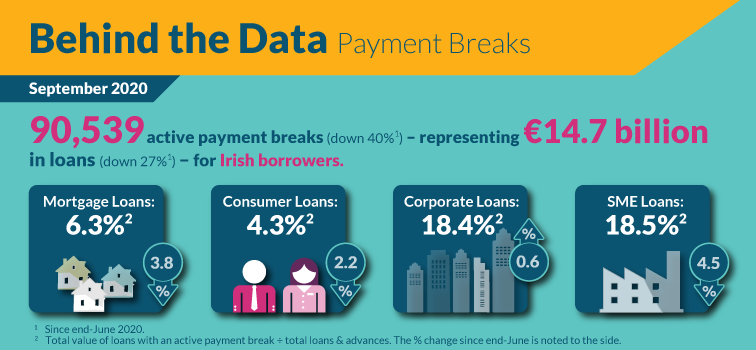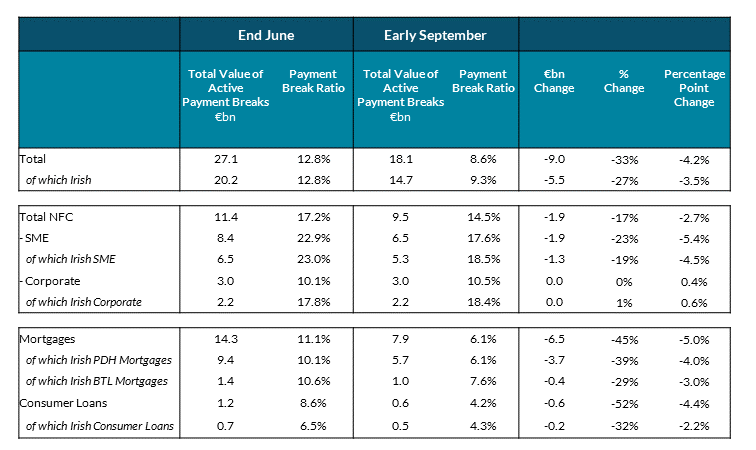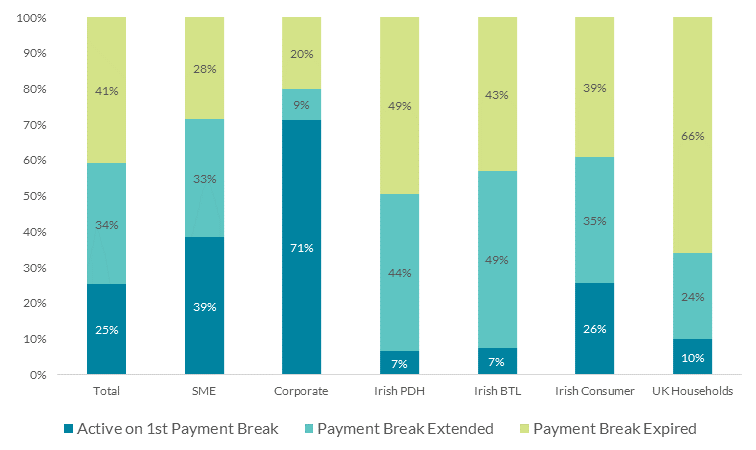Behind the Data

COVID-19 Payment Breaks – who continues to avail of them?
Allan Kearns, Andrew Campbell, Grace McDonnell, David Duignan, and Darren Greaney*
September 2020
New Central Bank data shows a 27% reduction in the value of active payment breaks to Irish borrowers since the end of June. Notwithstanding, 90,539 payment breaks remain active representing €14.7 billion or just over 9 per cent of loans to Irish borrowers.
COVID-19 has been an unprecedented shock to Ireland’s economy and has left thousands of households and businesses across the country on reduced incomes. In response to the COVID-19 pandemic, financial services firms in Ireland (including retail banks, retail credit firms, credit servicing firms and credit unions) have made payment breaks available to household and business customers. The initial applications for payment breaks, across all major types of loans (including mortgages, personal and business loans), peaked around mid-June. At that time, around €27bn or approximately 13% of all outstanding loan balances across these financial service providers had a payment break.
This “Behind the Data” provides an update on the prevalence of payment breaks across different categories of borrowers: households, small & medium sized enterprises (SMEs), and corporates. Aggregate data is provided across financial services firms initially, followed by additional industry sector breakdowns for Irish retail banks’ business borrowers (i.e. SME and corporate borrowers).
The Data
The figures are provided in an enhanced data collection from Irish retail banks, credit unions and retail credit and credit servicing firms. We refer to this grouping generically as “financial services firms”. The data in this note are at 4 September, with all credit unions reporting at 31 July. For additional context on the data source, including limitations of the data, see a recently published "Behind the Data" publication providing insights into borrowers that had applied for payment breaks by mid-June. Additional context on payment breaks is available in two research papers on the borrower characteristics of those with payment breaks.
The Scale of Payment Breaks across the Financial System

As of 4 September, there were 114,154 active payment breaks to all borrowers, representing €18.1 billion in loans or 8.6% of the outstanding loan balances. This is a 33% or €9 billion decrease from a peak at end-June 2020 when there were 220,546 active payments breaks representing €27.1 billion in loan balances (Table 1). Irish resident businesses (NFCs) and households account for approximately 80% of the total value of approved payment breaks to all households and NFCs. In this context, there are 90,539 active breaks as of 4 September representing €14.7 billion loans for Irish borrowers, equivalent to 9.3% of all outstanding loan balances.
Behind the aggregate share of 9.3% of all Irish borrowers’ loan balances with payment breaks, lies a significant difference between NFCs and households. While the ratio of outstanding loans for Irish households with payment breaks has almost halved to 6.2% since end-June, the NFC rate has reduced less so for SMEs and increased marginally for corporates. Within Irish NFCs, this payment break ratio is around 18.5% for Irish SMEs and corporates.
Table 1. Active Payment Breaks by Customer Type
 Notes: Value of payment breaks relate to the total loan balances outstanding that had an active payment break at the reporting date. Payment break ratio is the total value of loans with an active payment break ÷ total loans & advances.
Notes: Value of payment breaks relate to the total loan balances outstanding that had an active payment break at the reporting date. Payment break ratio is the total value of loans with an active payment break ÷ total loans & advances.
The Status of Payment Breaks
The countdown of the agreed duration of a payment break begins from the date a borrower applies. Most borrowers applied between end-March and end-June. Typically households were granted an initial three-month payment break with an option to extend for a further three months (i.e. six months in total). For some business borrowers, the initial break was granted for six months. An initial three-month decision point (where it applied) for borrowers to consider the need to extend a payment break or let it expire has passed for many but not all payment break borrowers. Based on the current schemes in place, borrowers will begin to come to the end of the maximum agreed duration of payment breaks from end-September 2020 onwards (i.e. six months after commencement of the schemes at end-March 2020).
Accordingly, borrowers can now be categorised as to whether:
- Their payment break has expired, with the borrower returning to full repayments or some form of arrears support
- Their payment break has been extended
- They remain active on their first payment break.
Of the share of implemented payment breaks by retail banks and retail credit & servicing firms to 4 September, 59% of all payment breaks remain active and 41% have expired. The 59% is the sum of 25% borrowers who remain active on the first payment break, and 34% who have received an extension (Chart 1). The category of borrower with the highest rate of expiration (66%) are UK households (i.e. mortgage and personal loans). The rate of expiration for Irish households is higher for principle dwelling home (PDH) mortgages (49%), buy-to-let (BTL) mortgages (43%) and personal loans (39%). In contrast, there is a lower rate of expiration for lending to SMEs and corporates where the rate is between 20%-28%. Overall, the vast majority of borrowers with expired payment breaks are returning to making full repayments. For instance, of the expired payment breaks within retail banks, over 90% have returned to full repayments on the existing term. This current high share is to be expected as borrowers typically will not yet have reached the maximum duration of the payment break schemes. In effect, borrowers are expiring early because they can resume payments.
Chart 1: Status of Payment Breaks
Some businesses and sectors remain more reliant on payment breaks than others.
The sectoral breakdown of the take-up of payment breaks reflects the inconsistent effects the pandemic is having on different parts of the economy. The data below relates to retail banks only.
Small and medium sized enterprises
Active payment breaks equate to 19.9% of all outstanding SME loans as at early September, reduced from around 27% at end-June. While the sectoral data show that there remains active payment breaks across all 19 categories of economic activities of SMEs (i.e. by two digit NACE sector) (Chart 2). However, in aggregate, payment breaks are concentrated in a handful of sectors. Almost four fifths of all SME payment breaks can be traced to the top five SME sectors (i.e. real estate activities, accommodation and food services, agriculture/forestry and fishing, wholesale and retail trade, and human health and social work activities). With the exception of agriculture/forestry and fisheries, with a relatively low payment break ratio (4%), ratios are of the order of 18%-46% across these remaining top sectors.
The outlier in terms of reliance on payment breaks remains the accommodation and food sector. Notwithstanding a reduction since end-June when two thirds of all loans had an active break; that payment break ratio remains high at 46%. This is consistent with how the pandemic has developed and how the associated restrictions have evolved.
Chart 2. SME Payment Breaks (Total SME portfolio and % of portfolio with a payment break)
.png?sfvrsn=65a58a1d_2)
Notes: Other is an aggregate of sectors where loans are less than €900 million.
Corporate Enterprises
Larger corporates differ to SMEs in that there has been effectively no reduction in the payment break ratio since late June. Active payment breaks continue to equate to around 10% of loans. Among larger businesses, the data show there are payment breaks across 13 of the 19 categories of economic activity (two digit NACE sectors) (Chart 3). Payment breaks are concentrated in the top 5 sectors by lending (i.e. manufacturing, real estate, wholesale & retail trade, accommodation & food services, and human health services) which account for almost three quarters of all payment breaks (Chart 3). Payment break ratios have remained relatively stable, with the notable exception of the human health and social work sector, which has seen payment breaks triple to 17% of all loans.
Chart 3. Corporate Payment Breaks (Total corporate portfolio and % of portfolio with a payment break)
.png?sfvrsn=62a58a1d_2)
Notes: Other is an aggregate of sectors where loans are less than €900 million.
Conclusion
Payment breaks are giving borrowers affected by the COVID-19 pandemic the opportunity to postpone or substantially reduce their repayments at a time of severe financial stress. The value of active payment breaks have fallen by one third since their peak at end-June. It is clear from the current data on active payment breaks that these continue to provide necessary relief for many borrowers. This is particularly true for Irish SME and corporate businesses, with firms operating in the accommodation and food service sector leading the way in terms of reliance on payment breaks. It is a positive development that, in aggregate, two fifths of payment breaks have expired early with the vast majority returning to full repayments. However, these positive statistics are skewed because at this time it is typically only those borrowers that could return to full repayments who would let their payment break expire early.
The nature of the pandemic means that it continues to cause a shock to incomes for some businesses and households, with differing impacts across sectors and households. For borrowers continuing to avail of payment breaks, these will continue to provide relief for a defined period. The Central Bank is focused on ensuring that financial services firms appropriately support borrowers in financial difficulty that are unable to return to full repayments following a payment break. At all times borrowers should engage with financial services firms, endeavour to make repayments where they can, and avoid accruing arrears where possible. The Central Bank expects financial services firms to have the operational capacity in place to engage with borrowers in financial difficulty to identify an appropriate and sustainable solution in these cases.
*Email [email protected] if you have any comments or questions on this note. Comments from Ed Sibley, Adrian Varley, Trevor Fitzpatrick, Caroline Meghan, Rory McElligott, Fergal McCann, Aisling Menton, Catharina Lawless, Steven Clarke and Maria Woods are gratefully acknowledged. The views expressed in this note are those of the authors and do not necessarily reflect the views of the Central Bank of Ireland or the ESCB/SSM.
See also: